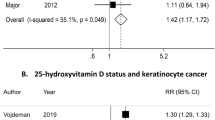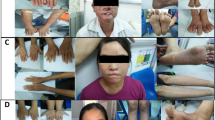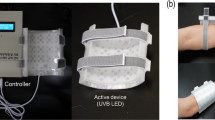Abstract
Background/objectives:
Xeroderma pigmentosum (XP) is a rare autosomal recessive disease characterized by defective repair of ultraviolet (UV) irradiation-induced DNA damage and high risk of skin cancer. Thus, these patients require strict photoprotection. Considering the importance of UV-mediated cutaneous vitamin D production, such rigorous photoprotection would cause vitamin D deficiency. Then, we have studied the vitamin D status in patients with XP-A, a group requiring the most strict photoprotection.
Subjects/methods:
Twenty-one patients with XP-A (aged 6–25) were evaluated for their vitamin D intake, serum levels of 25-hydroxy-vitamin D (25OHD) and parathyroid hormone (PTH). Vitamin D intake was assessed by a 2-day food weighing method.
Results:
Median dietary intake of vitamin D was 4.1 μg/day, and the median concentrations of serum 25OHD and PTH were 7.7 and 49.9 pg/ml, respectively. In 76% of the patients, serum 25OHD level was lower than 10 ng/ml, indicating vitamin D deficiency. Vitamin D intake and serum 25OHD level were significantly lower in patients under enteral nutrition (EN) than those with oral intake (OI). Multivariate analyses revealed that EN was a significant predictor of decreased serum 25OHD level (β coefficient=−0.59, P=0.03).
Conclusions:
Vitamin D deficiency is highly prevalent in XP-A patients, and supplementation should be considered to avoid unfavorable skeletal consequences in these patients. In addition, determination of dietary vitamin D requirement has been a difficult work issue in the decision of dietary reference intakes (DRIs) because of its cutaneous production. Data from XP patients would yield useful information for the determination of DRIs for vitamin D.
This is a preview of subscription content, access via your institution
Access options
Subscribe to this journal
Receive 12 print issues and online access
$259.00 per year
only $21.58 per issue
Buy this article
- Purchase on Springer Link
- Instant access to full article PDF
Prices may be subject to local taxes which are calculated during checkout
Similar content being viewed by others
References
Cleaver JE . Defective repair replication of DNA in xeroderma pigmentosum. Nature 1968; 218: 652–656.
Hirai Y, Kodama Y, Moriwaki S, Noda A, Cullings HM, Macphee DG et al. Heterozygous individuals bearing a founder mutation in the XPA DNA repair gene comprise nearly 1% of the Japanese population. Mutat Res 2006; 601: 171–178.
Bradford PT, Goldstein AM, Tamura D, Khan SG, Ueda T, Boyle J et al. Cancer and neurologic degeneration in xeroderma pigmentosum: long term follow-up characterises the role of DNA repair. J Med Genet 2011; 48: 168–176.
Holick MF . Evolution and function of vitamin D. Recent Results. Cancer Res 2003; 164: 3–28.
Hossein-Nezhad A, Holick MF . Vitamin D for health: a global perspective. Mayo Clin Proc 2013; 88: 720–755.
Tang JY, Fu T, Lau C, Oh DH, Bikle DD, Asgari MM . Vitamin D in cutaneous carcinogenesis: part II. J Am Acad Dermatol 2012; 67: e1–11.
Ministry of Education, Culture, Sports, Science and Technology; the Government of Japan. Standard tables of food composition in Japan 2010. Printing Bureau, Ministry of Finance: Tokyo, 2010 (in Japanese).
Holick MF, Binkley NC, Bischoff-Ferrari HA, Gordon CM, Hanley DA, Heaney RP, Murad MH, Weaver CM . Evaluation, treatment, and prevention of vitamin D deficiency: an Endocrine Society Clinical Practice Guideline. J Clin Endocrinol Metab 2011; 96: 1911–1930.
Pludowski P, Holick MF, Pilz S, Wagner CL, Hollis BW, Grant WB, Shoenfeld Y, Lerchbaum E, Llewellyn DJ, Kienreich K, Soni M . Vitamin D effects on musculoskeletal health, immunity, autoimmunity, cardiovascular disease, cancer, fertility, pregnancy, dementia and mortality- a review of recent evidence. Autoimmun Rev 2013; 12: 976–989.
Kraemer KH, Lee MM, Scotto J . Xeroderma pigmentosum. Cutaneous, ocular, and neurologic abnormalities in 830 published cases. Arch Dermatol 1987; 123: 241–250.
Kraemer KH, Patronas NJ, Schiffmann R, Brooks BP, Tamura D, DiGiovanna JJ . Xeroderma pigmentosum, trichothiodystrophy and Cockayne syndrome: a complex genotype-phenotype relationship. Neuroscience 2007; 145: 1388–1396.
Ministry of Health, Labour, and Welfare, Japan Dietary reference intakes for Japanese. Daiichi Shuppan Publishing Co, Ltd: Tokyo, (2015).
Sollitto RB, Kraemer KH, DiGiovanna JJ . Normal vitamin D levels can be maintained despite rigorous photoprotection: six years' experience with xeroderma pigmentosum. J Am Acad Dermatol 1997; 37: 942–947.
Hoesl M, Dietz K, Röcken M, Berneburg M . Vitamin D levels of XP-patients under stringent sun-protection. Eur J Dermatol 2010; 20: 457–460.
Valcour A, Blocki F, Hawkins DM, Rao SD . Effects of age and serum 25-OH-vitamin D on serum parathyroid hormone levels. J Clin Endocrinol Metab 2012; 97: 3989–3995.
Sahota O, Mundey MK, San P, Godber IM, Hosking DJ . Vitamin D insufficiency and the blunted PTH response in established osteoporosis: the role of magnesium deficiency. Osteoporos Int 2006; 17: 1013–1021.
DeLong LK, Wetherington S, Hill N, Kumari M, Gammon B, Dunbar S et al. Vitamin D levels, dietary intake, and photoprotective behaviors among patients with skin cancer. Semin Cutan Med Surg 2010; 29: 185–189.
Garland CF, French CB, Baggerly LL, Heaney RP . Vitamin D supplement doses and serum 25-hydroxyvitamin D in the range associated with cancer prevention. Anticancer Res 2011; 31: 607–611.
Institute of Medicin 2011 Dietary reference intakes for calcium and vitamin D. The National Academies Press: Washington, DC, 2011.
Yoshimura N, Muraki S, Oka H, Morita M, Yamada H, Tanaka S, Kawaguchi H, Nakamura K, Akune T . Profiles of vitamin D insufficiency and deficiency in Japanese men and women: association with biological, environmental, and nutritional factors and coexisting disorders: the ROAD study. Osteoporos Int 2013; 24: 2775–2787.
Armas LA, Dowell S, Akhter M, Duthuluru S, Huerter C, Hollis BW, Lund R, Heaney RP . Ultraviolet-B radiation increases serum 25-hydroxyvitamin D levels: the effect of UVB dose and skin color. J Am Acad Dermatol 2007; 57: 588–593.
Rockell JE, Skeaff CM, Williams SM, Green TJ . Association between quantitative measures of skin color and plasma 25-hydroxyvitamin D. Osteoporos Int 2008; 19: 1639–1642.
Hall LM, Kimlin MG, Aronov PA, Hammock BD, Slusser JR, Woodhouse LR, Stephensen CB . Vitamin D intake needed to maintain target serum 25-hydroxyvitamin D concentrations in participants with low sun exposure and dark skin pigmentation is substantially higher than current recommendations. J Nutr 2010; 140: 542–550.
Nessvi S, Johansson L, Jopson J, Stewart A, Reeder A, McKenzie R, Scragg RK . Association of 25-hydroxyvitamin D3)levels in adult New Zealanders with ethnicity, skin color and self-reported skin sensitivity to sun exposure. Photochem Photobiol 2011; 87: 1173–1178.
Libon F, Cavalier E, Nikkels AF . Skin color is relevant to vitamin D synthesis. Dermatology 2013; 227: 250–254.
Godar DE, Pope SJ, Grant WB, Holick MF . Solar UV doses of adult Americans and vitamin D(3) production. Dermatoendocrinol 2011; 3: 243–250.
Kaneko F, Nakamura K, Furukawa H, Oyama N, Nakamura T, Zheng X . Biological characteristics of the sensitive Japanese skin. Int J Cosmetic Sci 2005; 27: 66–67.
Acknowledgements
This work was supported by JSPS KAKENHI Grant Number 25750061 and 25350157.
Author information
Authors and Affiliations
Corresponding author
Ethics declarations
Competing interests
The authors declare no conflict of interest.
Rights and permissions
About this article
Cite this article
Kuwabara, A., Tsugawa, N., Tanaka, K. et al. High prevalence of vitamin D deficiency in patients with xeroderma pigmetosum-A under strict sun protection. Eur J Clin Nutr 69, 693–696 (2015). https://doi.org/10.1038/ejcn.2015.1
Received:
Revised:
Accepted:
Published:
Issue Date:
DOI: https://doi.org/10.1038/ejcn.2015.1
This article is cited by
-
Recent Developments in the Diagnosis and Management of Photosensitive Disorders
American Journal of Clinical Dermatology (2018)
-
UV-Filter und Endokrinium
Gynäkologische Endokrinologie (2016)



